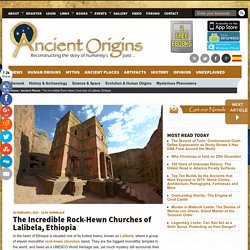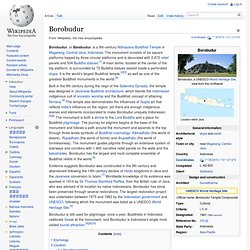

Historyczne odkrycie na "Górze Zyndrama" Odkrycie jest rewolucyjne, ponieważ do tej pory najstarszymi kamiennymi obiektami architektonicznymi znanymi w tej części Europy były kościoły datowane na X wiek.

Wykopaliska z Maszkowic są od nich starsze o - bagatela! - 2500 lat. Zdaniem archeologów, mamy do czynienia z pozostałościami warowni obronnej. Prawdopodobnie była zamieszkana przez mniej więcej 200 lat, a populacja wahała się w okolicach ok. 150-200 osób. Nie wiadomo jednak, do jakiej cywilizacji należeli ci ludzie. Prace archeologiczne na "Górze Zyndrama" W 2010 roku ekspedycja z Instytutu Archeologii rozpoczęła prace w niebadanej dotąd strefie stanowiska, w miejscu gdzie gwałtownie kończy się szczytowe wypłaszczenie "Góry Zyndrama" i zaczyna się jej wschodni stok. The Incredible Rock-Hewn Churches of Lalibela, Ethiopia.
In the heart of Ethiopia is situated one of its holiest towns, known as Lalibela, where a group of eleven monolithic rock-hewn churches stand.

They are the biggest monolithic temples in the world, and listed as a UNESCO World Heritage site, yet much mystery still surrounds their construction. The age of these buildings is unknown, but legends mention that they were excavated during the reign of Gebre Mesqel Lalibela, who ruled Ethiopia at the beginning of the 13th century AD. His name means ‘the bees recognize him as a king’.
La Ciudad Blanca. La Ciudad Blanca (pronounced: [la sjuˈðað ˈblaŋka], Spanish for "The White City") is a legendary settlement said to be located in the Mosquitia region of the Gracias a Dios Department in eastern Honduras.

This extensive area of rainforest, which includes the Río Plátano Biosphere Reserve, has long been the subject of multidisciplinary research. Archaeologists refer to it as being a part of the Isthmo-Colombian Area of the Americas, one in which the predominant indigenous languages included those in the Chibchan and Misumalpan families. Due to the many variants of the story in the region, most professional archaeologists doubt it refers to any one actual settlement, much less one representing a city of the Pre-Columbian era. [citation needed] Spanish conquistador Hernán Cortés reported hearing "trustworthy" information on a region with "towns and villages" of extreme wealth in Honduras, but never located these.
Background[edit] History[edit] Spanish conquest[edit] Super Megaliths in Gornaya Shoria, Southern Siberia. Megaliths in Gornaya Shoria, Southern Siberia I subscribe to a couple of Russian Blogs and Websites that post various data and information without the typical hype and filters of Western Science, Academia and the Press, let alone the fringe and "Alien" woo-woo crowd interests.

The following are photos of some Super Megaliths from Southern Siberia near the mountains of Gornaya Shoria. The super megaliths were found and photographed for the first time by Georgy Sidorov on a recent expedition to the Southern Siberian mountains. The following images are from Valery Uvarov's Russian website. Submerged Cities: 7 Underwater Wonders of the World.
Baalbek - A Colossal Enigma. By Gian J.

Quasar This article introduces and discusses new discoveries made in the colossal ruins at Baalbek, Lebanon, and the possibility they are evidence of a past supercivilization or, at least, technically advanced civilization of “prehistory.” Overview Baalbek is the name of an archeological site in Lebanon. In Roman times it was known as Heliopolis or City of the Sun.
Moreover, this temple was built on a “tel” or ruin mound, indicating a place that had long been held sacred, though what had caused this area to be significant or “sacred” is unknown. A panorama of ancient Baalbek, seen from a nearby hill. Są ich tysiące. Rzeźby, obrazy, budowle... Wszystkie wspaniałe. A refutation of the history channel show Ancient Aliens. What is the White Dragon Magazine. What is White Dragon?

WHITE DRAGON began at Samhain 1993 as the modest 8-page, photocopied and side-stapled newsletter of the Mercian region of the now long-defunct PaganLink under the editorship of Rowan. When PaganLink collapsed nationally less than a year later the region also disbanded and it was agreed amongst the local co-ordinators that Rowan could keep White Dragon as no-one else wanted it. Never volunteer for anything. See where it leads. Erik Schimek - 9 steps to understanding Gobekli Tepe. Posted on Monday, 19 April, 2010 | 2 comments Columnist: Erik Schimek.

10 Mysteries That Hint At Forgotten Advanced Civilizations. Mysteries Prehistory literally means the time “before we had written records” (roughly the time before the 4th Century BC) and ancient history is the time since our recorded history.

Our concept of ancient history was originally firmly determined by the bible. Written from an insular point of view, the histories of some ancient cultures were distorted, badly neglected or even omitted. The existence of inexplicable monuments, certain man-made marvels and archaeological finds pertaining to our ancient- and prehistory, are leading more and more archaeologists to believe long forgotten advanced civilizations existed. As most of our ancient records were lost during the destruction of the great libraries, the following genuine mysteries are the only remnants of their existence. Ancient knowledge was a lot more refined and developed than we have been taught hitherto. Despite wars and several invasions, India’s ancient history was largely preserved. Top 10 Most Overlooked Mysteries in History. Mysteries Over the last few months we have gone through 30 of the worlds greatest mysteries but what we haven’t covered are ancient mysteries.

This list aims to put that right! Here are ten great unsolved mysteries of science. Artifacts of the Lost Global Civilization.
EGIPT. Klaus Dona 'The Lost Pyramids & Ancient Artifacts' Borobudur. Borobudur, or Barabudur, is a 9th-century Mahayana Buddhist Temple in Magelang, Central Java, Indonesia.

The monument consists of six square platforms topped by three circular platforms and is decorated with 2,672 relief panels and 504 Buddha statues.[1] A main dome, located at the center of the top platform, is surrounded by 72 Buddha statues seated inside a perforated stupa. It is the world’s largest Buddhist temple,[2][3] as well as one of the greatest Buddhist monuments in the world.[4] Evidence suggests Borobudur was constructed in the 9th century and abandoned following the 14th-century decline of Hindu kingdoms in Java and the Javanese conversion to Islam.[7] Worldwide knowledge of its existence was sparked in 1814 by Sir Thomas Stamford Raffles, then the British ruler of Java, who was advised of its location by native Indonesians. Borobudur has since been preserved through several restorations. Etymology[edit] Borobudur stupas overlooking a mountain. Location[edit] History[edit] Presents Ajanta and Ellora caves including Kailasa Temple.
The scale at which the work was undertaken is enormous. It covers twice the area of the Parthenon in Athens and is 1.5 times high, and it entailed removing 200,000 tonnes of rock. It is believed to have taken 7,000 labourers 150 years to complete the project. The rear wall of its excavated courtyard 276 feet (84 m) 154 feet (47 m) is 100 ft (33 m) high. The temple proper is 164 feet (50 m) deep, 109 feet (33 m) wide, and 98 feet (30 m) high. Kailasa Temple, cave #16 at Ellora, India Full resolution (1,280 × 960 pixels, file size: 545 KB, MIME type: image/jpeg)
Indus Valley Civilization. YETI. The Mystery of Bosnia's Ancient Pyramids. Nubia. Yonaguni. Chiny. Ślęża. Malta. Ten Greatest Archaeological Artifacts. La revelación de las Pirámides 'La investigación que cambiará el mundo'.webm. Lost civilizations of the Andes (1) David Pratt Jan 2010, Aug 2011 Part 1 of 2 Contents Part 1 1. The Incas [08/11] 2. Pre-Inca cultures [08/11] 3. Transoceanic contacts [08/11] 4. The Nazca lines Part 2 5. ‘Inca’ stonemasonry [08/11] 6. Fig. 1.1 Inca expansion. 3 The Inca pantheon was presided over by Viracocha, followed by Inti, the sun god, and Pachamama, the earth goddess. Mystic Places - Ollantaytambo, Tiwanaku and Aramu Muru. Introduction | Stone Technology | Aramu Muru | Books | Websites Introduction At the northern end of the Sacred Valley, Ollantaytambo is rare if not unique in Peru.
Ollantaytambo is a massive citadel located 50 kilometers from Machu Picchu. The citadel served as both a temple and a fortress. At some time unknown, and for reasons unknown, work mysteriously stopped on this huge project. Cuzco Peru 2012 New. The Pyramids of Caral in Peru. The archaeological site of Caral remains a minor blip on the tourist radar in Peru, certainly in comparison to major attractions and household names such as Machu Picchu and the Nazca Lines.
Despite being largely overlooked by both foreign and local tourists, Caral is very much a key site for students of ancient Peruvian and South American history. Top 10 Bizarre & Controversial Archeological Discoveries. Many strange archeological discoveries have been made in modern history. Hundreds of artifacts have been unearthed that have baffled scientists and challenged modern man’s view of history. Many of these objects have been labeled out of place artifacts or anachronisms. These archeological discoveries are always controversial and the scientific community is extremely selective in what they accept as fact. Every object on this list has been accused of being an elaborate hoax. Kerma. Kerma (now known as Dukki Gel, a Nubian term which can be roughly translated as "red mound") was the capital city of the Kingdom of Kerma, which was located in present day Egypt and Sudan.
Kerma is one of the largest Nubian archaeological sites. It has produced decades of extensive excavations and research, including thousands of graves and tombs and the residential quarters of the main city surrounding the Western/Lower Deffufa. The Kerma site has been confirmed by archaeology to be at least 9,500 years old.[1][2] Around 3000 BC, a cultural tradition began around Kerma. Kerma was a large urban center that was built around a large mud brick temple, known as the Western Deffufa.[3] Some unique aspects of this culture were beautiful pottery, the importance of cattle, a system of defense, and the King's audience chamber, which bears no resemblance to any Egyptian building (it was rebuilt 10 times).[4]
MAJOWIE.